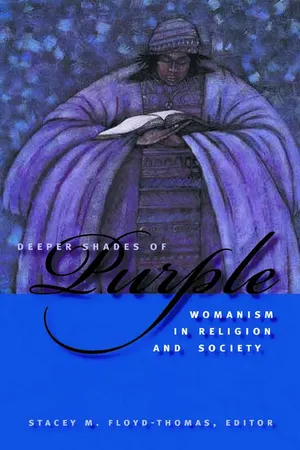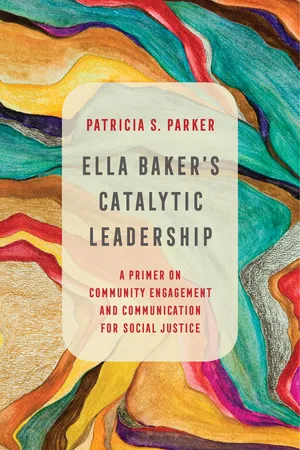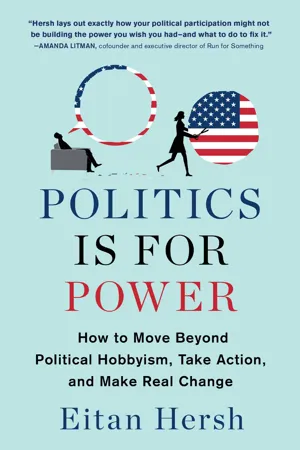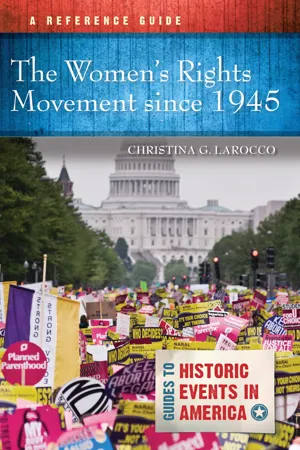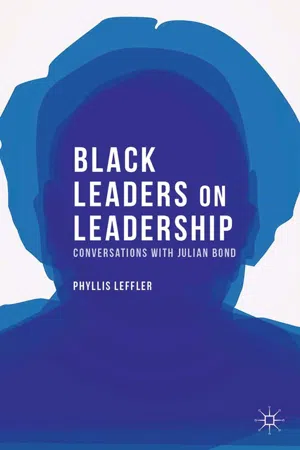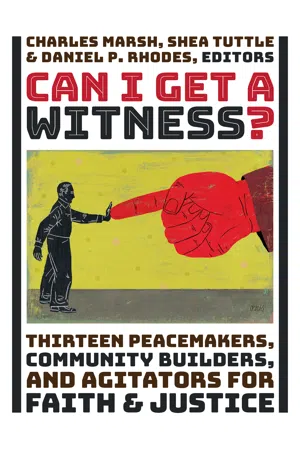History
Ella Baker
Ella Baker was a prominent African American civil rights activist and leader. She played a key role in the civil rights movement, working alongside prominent figures such as Martin Luther King Jr. and W.E.B. Du Bois. Baker was known for her grassroots approach to organizing and empowering local communities, and she was a driving force behind the formation of the Student Nonviolent Coordinating Committee (SNCC).
Written by Perlego with AI-assistance
Related key terms
8 Key excerpts on "Ella Baker"
- eBook - ePub
Deeper Shades of Purple
Womanism in Religion and Society
- Stacey M. Floyd-Thomas(Author)
- 2006(Publication Date)
- NYU Press(Publisher)
14 allows them to fashion a religiosity that carries on while expanding the tradition from which they emerged. Another example is evident in the life and work of Ella Baker: focused social activism. Born in 1903 in Norfolk, Virginia, Ella Baker has become known as one of the persons who helped conceptualize, shape, and carry on the Civil Rights movement. Baker attended and graduated from Shaw University in Raleigh, North Carolina, in the 1920s. After graduation, Baker decided against the anticipated profession of schoolteacher, and instead moved to New York where she took odd jobs while developing a career for herself in community work. During the 1930s, Baker was an active officer of the Young Negroes’ Cooperative League which sought to improve the lives of Depression era black persons through co-op buying. From around 1940 to 1946, she served as a field secretary and later as director of branches for the national NAACP. After leaving NAACP employment, she worked with the Urban League and a local New York NAACP branch. Because Baker began her lifelong vocation of community organizing as early as the late 1920s, she was not only deeply familiar with evolving social and political developments in the country, but she also was insightful enough to recognize and to take full advantage of the potential of the time during which she lived. This is how she came to help shape the Civil Rights movement.From New York, Ella Baker supported the Montgomery Bus Boycott through fundraising efforts. Later she helped initiate organization of the Southern Christian Leadership Conference (SCLC) to capitalize on the boycott’s social gains after it ended. In 1957, Baker moved south to Atlanta and developed the administrative and programmatic infrastructure of the newly formed SCLC, becoming its de facto first executive director, though her gender and her status as a lay person prevented Baker’s ever formally holding the title. As her work with the SCLC was ending, Baker helped organize student leaders of sit-ins and, seeing great potential in the young people’s energy and enthusiasm, Baker encouraged students to form their own organization. This resulted in emergence of the Student Non-Violent Coordinating Committee (SNCC). Over the course of her career Baker emphasized empowering people. She once said, “Give people the light and they will find a way.”15 - eBook - ePub
North Carolina Women
Their Lives and Times
- Michele Gillespie, Sally McMillen(Authors)
- 2015(Publication Date)
- University of Georgia Press(Publisher)
SNCC , arguably the most radical civil rights organization in the early 1960s, is the achievement for which Baker is often remembered. It was through this organization that her philosophy was most clearly formulated and expressed.Baker, and almost every other person who fought for civil rights in the 1950s and 1960s, has become a part of a pantheon of great Americans who have been pinned to a neatly ordered narrative that begins in 1954 with the Brown v. Board of Education Supreme Court decision and ends with the 1965 Voting Rights Act. These short but strident years of the civil rights movement have been the subject of much debate in recent years. Many historians have called for a more expansive understanding of the movement and have advocated an extended framework, the “long civil rights movement.”4 This new framework roots the political, social, and temporal origins of the civil rights movement in the 1930s rather than in post–World War II America and illustrates the fundamental place of economic justice alongside political and social equality in the movement. Ella Baker’s life illuminates the binding ties between the radicalism of the 1930s and the “classical phase” of the movement two decades later. Her work is testament to the ways in which the democratic ideals cultivated in the Great Depression fundamentally shaped the discourse and desires of the American civil rights movement.ELLA JOSEPHINE BAKER Baker called the 1960 meeting of student activists in Raleigh, North Carolina, that created the Student Non-Violent Coordinating Committee. Photo by Danny Lyon, Magnum Photos.Ella Josephine Baker was born on December 13, 1903, in Norfolk, Virginia, to Georgianna (Anna) and Blake Baker. She was the middle of three surviving children, with an older sister and a younger brother. Baker’s parents were born and raised in eastern North Carolina. Her father’s parents were tenant farmers from the small town of Warrenton, North Carolina; her mother’s family came from the nearby riverside community of Elam, near Littleton. Blake Baker and Anna Ross married in North Carolina in 1896, the same year that the U.S. Supreme Court upheld Jim Crow laws by a 7–1 vote in Plessy v. Ferguson . The newlyweds, like tens of thousands of blacks in the post-Reconstruction South, faced limited opportunities in rural communities of old plantations and newer tenant farms. In 1900, three years before Ella’s birth, the Bakers moved to the port city of Norfolk. Blake and Anna Baker’s migration from the farmlands of North Carolina to the city was part of a larger exodus of African Americans from the southern countryside at the turn of the century. In Norfolk alone the labor force increased fivefold between 1880 and 1900.5 - eBook - ePub
Sisters in the Struggle
African American Women in the Civil Rights-Black Power Movement
- Bettye Collier-Thomas, V.P. Franklin(Authors)
- 2001(Publication Date)
- NYU Press(Publisher)
In addition to the lessons Ella Baker conveyed and the example she set, she also provided SNCC activists with a strong connection to history. A common myth about the Civil Rights Movement, especially the Black Power phase of the movement, is that these periods of intense political protest simply erupted on the national scene with little connection to early periods of struggle. But while the intensity and widely publicized character of the protests may have represented a departure from the past, the spirit of determined resistance did not. Ella Baker often railed against the stereotype that black southerners were passive and complacent before 1955. And if any single life or political career belied this myth, it was hers.Ella Baker fought on the front lines of the Black Freedom Movement in the United States for over a half century. After her arrival in Harlem in the late 1920s, she immersed herself in the radical political activities there. She condemned Italy’s invasion of Ethiopia. She protested the unfair treatment of black domestic workers during the Depression. And she helped launch the Young Negroes Cooperative League to ameliorate the suffering of the poor and explore socialist alternatives to capitalism. During World War II she joined forces with the National Association for the Advancement of Colored People, and traveled throughout the South recruiting new members. She raised funds for the Montgomery Bus Boycott and left her home in New York City to move to Atlanta, where she served as the first staff person of the coalition that emerged out of it, the Southern Christian Leadership Conference. Most notably, in 1960 Ella Baker was instrumental in the formation of the Student Nonviolent Coordinating Committee, an organization that would become a pivotal and catalytic force within the growing liberation movement.Ella Baker was an advisor, a teacher, and a confidante to many young people who came of age politically in the 1960s. But she knew much more about their lives than they knew about hers. In the words of SNCC leader and Baker protege Robert Moses, “We didn’t know much about Ella’s life before SNCC … (but) she brought (that) history with her.”5 - eBook - ePub
Communication for Social Justice Activism
A Primer on Community Engagement and Communication for Social Justice
- Patricia S. Parker(Author)
- 2020(Publication Date)
- University of California Press(Publisher)
1 Translating Ella Baker’s Legacy of Social Justice Leadership into Everyday PraxisI have always thought what is needed is the development of people who are interested not in being leaders as much as in developing leadership among other people. Ella Baker (1972, p. 352)When then presidential candidate Barack Obama was preparing for the 2008 Democratic primaries in South Carolina, Anton Gunn, “a self-confident young community organizer,” told Mr. Obama’s campaign strategists in Chicago that if they wanted to win in South Carolina, they should enlist the “ ‘[Ms.] Mary’s,’ older women who were centers of good will and polite gossip in the black churches, who had a hand in every charity event and Bible-study group” (Remnick, 2015, p. 26). The strategists heeded that advice. Candidate Obama went on to win the primary by a landslide over challengers Hillary Clinton and John Edwards (“Election 2008,” 2016). I do not mean to suggest that Black women were the only reason Obama won in South Carolina, but they were certainly a factor, as they have been in more recent political races (Bowerman, 2017). But Gunn’s reference to the “Ms. Marys” in a community does speak to the organizing tradition of bridge leadership in Black women’s history, a historical tradition of organizing that can be traced (at least) back to antiracist resistance to chattel slavery in the United States and that found traction during the twentieth-century movements for education reform, civil rights, and protections against sexual violence (Robnett, 1996). It is a tradition of leadership that has been passed on through carriers, such as Ella Baker and others throughout the world, who believed, as exemplified in the opening quote, in the development of social justice leadership in other people (Baker, 1972; Parker, 2004; Payne, 1995/2007).This chapter translates Ella Baker’s philosophy into everyday praxis. It connects Black women’s bridge leadership to critical organizing concepts advanced by the Italian philosopher Antonio Gramsci (1891–1937). In her comprehensive biography of Baker, Barbara Ransby made a similar comparison. Her intent was not to somehow legitimize Ella Baker’s ideas by likening them to those of a European philosopher, as some critics have alleged (Ransby, 2003).1 Rather, she argued persuasively that such comparisons necessarily write Black women’s intellectual thought back into the academic canons that have erased and ignored them. Positioning Black women’s intellectual history within the context of other ideas, Ransby observed, subverts the tendency to “essentialize and isolate black thought from parallel ideologies” (2003, p. 419). It also expands intellectual thought. Antonio Gramsci was born only twelve years before Ella Baker, making them contemporaries at the height of his political engagement: Gramsci in southern Italy in the 1920s and 1930s, under Mussolini’s fascist regime, and Baker in Depression-era Harlem, New York, later in the Jim Crow South, and finally in global antiracist movements. Gramsci died as a political prisoner at a relatively young age and therefore was unable to fully test his ideas in the field.2 - eBook - ePub
Politics Is for Power
How to Move Beyond Political Hobbyism, Take Action, and Make Real Change
- Eitan Hersh(Author)
- 2020(Publication Date)
- Scribner(Publisher)
1 Baker is largely unknown to the public, but she was one of the most important figures in the American civil rights movement. Before she formed the Mississippi Freedom Democratic Party, which demanded participation in the 1964 Democratic National Convention; before she led students to create the Student Nonviolent Coordinating Committee (SNCC) in 1960; before she ran the operations of Martin Luther King’s Southern Christian Leadership Conference (SCLC); Baker was the lead organizer for the National Association for the Advancement of Colored People (NAACP).During World War II, a surge of civic engagement across the country drew many new black Americans to NAACP chapters. Baker wanted to take advantage of the moment and help local chapters grow into durable organizations that could be leveraged for future civil rights work. She wanted the local organizations to take concrete political action in their communities. The chapters wouldn’t be strong if all they did was raise money for the national organization. They needed to have a plan that they, not some national committee, were in charge of.In 1941 and 1942, then in her late thirties, Baker spoke at over a hundred chapters around the country, and even more church groups and other organizations. She kept a grueling pace, speaking about the value of organizing, patiently answering questions, and recruiting volunteers.The story goes that when she was visiting Albany, New York, Baker learned something that unsettled her about the schools in Albany. The schools used a tiered tracking system. The highest level was for college preparation. The middle level was for vocational training. And the third tier, according to one of Baker’s biographers, “did little more than mark attendance.” Most of Albany’s black students were placed by the school district into that third tier.2When Baker spoke at a meeting with the Albany NAACP branch, all that anyone wanted to talk about was the Deep South, where the racial violence was most intense. Whenever Baker traveled outside the Deep South, it seemed as if the middle-class attendees who dominated chapter meetings mainly wanted to hear from Baker about how things were going in the Deep South. Baker was outraged. “They were always talking about the poor people down South,” she said. “And so the question was, what do you do about the poor children right here?” When she heard people talking endlessly about the South, “[that] meant to them that’s where the problem was and they had not identified the problem in their own area.”3 - eBook - ePub
The Women's Rights Movement since 1945
A Reference Guide
- Christina G. Larocco(Author)
- 2022(Publication Date)
- ABC-CLIO(Publisher)
State Press and were sometimes able to help secure trials and, occasionally, even convictions.Ella Baker AND THE STUDENT NONVIOLENT COORDINATING COMMITTEEThe modern civil rights movement comprised a number of different leadership styles that reflected different strategies and goals. To understand the role of women in the civil rights movement and the relationship between this activism and the women’s rights movement, two are especially important.The first strategy, the top-down leadership tradition, was the most visible and is the best known today. Exemplified by men like King and organizations like the Southern Christian Leadership Conference (SCLC), which King founded after the success of the Montgomery Bus Boycott, and the NAACP, this strategy focused on large-scale, national events. This tradition reflected the assumption that well-educated members of the clergy and other national leaders—almost, if not entirely, all men—influenced the masses.The 1963 March on Washington exemplified this strategy. Not coincidentally, this event pushed women to the sidelines. Despite the national prominence of women including Rosa Parks, Dorothy Height, Ella Baker, and many others—and despite organizer Bayard Rustin’s own experiences with discrimination as a gay Black man—women were nearly invisible at the march. Only one, Daisy Bates (replacing Medgar Evers’s widow, Myrlie, who was stuck in traffic), spoke. They did not meet with the president, and they did not march with King and the other male leaders—instead, the movement’s most prominent women marched with the wives of their male counterparts.The second tradition was the grassroots community-organizing tradition, exemplified by women like Ella Baker and Fannie Lou Hamer and men including Baker’s protégé, Bob Moses. Reflecting women’s unheralded work in the Black church and other institutions, ordinary women were the foot soldiers of this movement, which assumed that, in Baker’s words, “strong people don’t need strong leaders.” In this view, local people knew best how to solve their own problems and end their own oppression, and thus, they—not well-educated, elite outsiders—needed to be the leaders of any movement for social change. - eBook - ePub
Black Leaders on Leadership
Conversations with Julian Bond
- P. Leffler(Author)
- 2014(Publication Date)
- Palgrave Macmillan(Publisher)
58Ella Baker built upon her mother’s activism in black Baptist women’s groups.59 Her thinking about social change evolved further in Harlem during the 1920s. A founding member of the Youth Negroes’ Cooperative League, she helped develop a five-year plan for economic empowerment; by 1931, she was its national director. At the same time, she became involved in journalistic activism, writing for the Negro National News, the Pittsburgh Courier , and the Norfolk Journal and Guide. She came to see the power of grassroots activism as she continued organizing efforts in the American Labor Party, and later within the NAACP as a field organizer.60 It was this philosophy and skill that she brought to SNCC. She linked past and present for young people with a short sense of history.61Ella Baker encouraged individuals to listen and talk until consensus was reached. She taught people how to subsume their individual differences and to encourage collective action. She was not concerned that the young people involved in SNCC might err; rather, she claimed that they had the right to make their own mistakes, and that the movement was their own. She was a fine listener and a shepherd, always reflecting the view that individual opinion should be respected.62 Deeply suspicious of King’s cult personality leadership, she argued that real leadership was a form of teaching, and that success could be measured in terms of process. What mattered was the ability to pass on strategies for change—to be a fundi —as Bob Moses later said and as Joanne Grant eulogized at her funeral in 1986.63 - eBook - ePub
Can I Get a Witness?
Thirteen Peacemakers, Community-Builders, and Agitators for Faith and Justice
- Charles Marsh, Shea Tuttle, Daniel P. Rhodes, Charles Marsh, Shea Tuttle, Daniel P. Rhodes(Authors)
- 2019(Publication Date)
- Eerdmans(Publisher)
28 She refused to permit the student’s efforts, including their leadership during the sit-ins, to become window dressing to the work of the ministerial establishment. When SCLC leaders persisted in their attempt, Baker walked out of the caucus.Her action shook the caucus and the entire movement. “Baker’s departure [from the caucus] signaled the beginning of a new phase for the civil rights movement. It was no longer controlled by a stodgy ministerial or bureaucratic presence. It was to be led by a new force.”29Despite Baker’s anger over the SCLC’s plan, she acted in good faith; she refused to twist arms to make the vote fall her way. Certainly, the SCLC possessed indispensable resources and political access that offered foundation and structure to the movement as a whole. Yet Baker maintained a position that became a hallmark of her Christian witness: there would be no movement without empowering and prioritizing the young people. The relationship between the SCLC and the SNCC remained tense, but the SNCC did continue as a student-led organization.While Baker supported the students in their efforts, she insisted that the movement was about larger issues than lunch counters; it was about “more than a hamburger and a Coke.”30 True freedom required learning to treat others with dignity and equality outside of the realms of economics and politics. It was about teaching others to love freedom and to do the work required to sustain it. Baker considered human equality to be a divine calling, a state that was good for its own sake. And she offered the students another perspective on their organizing without dousing the flames of the passionate pursuit of their own most important issues and campaigns.Baker didn’t just teach the content of freedom to the students; she modeled what was required to live an authentically free life. This authenticity was key to her advocacy. “What was nice about Miss Baker,” according to one SNCC worker, “is you never felt that she had a personal agenda that she was trying to put on. It was always about what is good for the organization, for black people, for whatever the larger issue was. [With] other adults you never really knew what was hidden.”31
Index pages curate the most relevant extracts from our library of academic textbooks. They’ve been created using an in-house natural language model (NLM), each adding context and meaning to key research topics.
